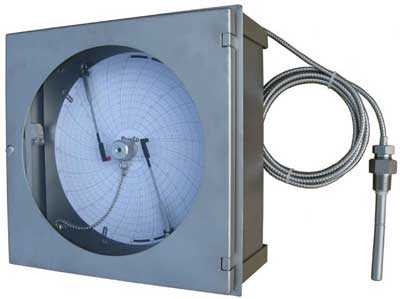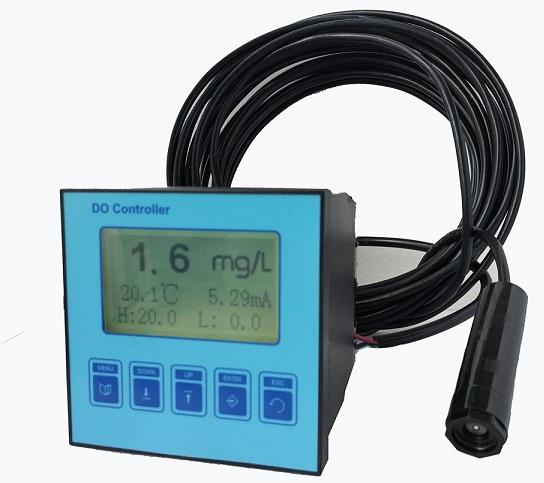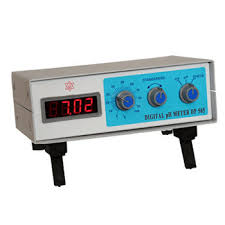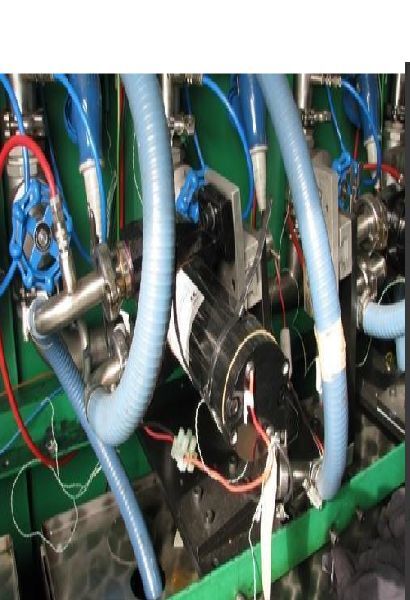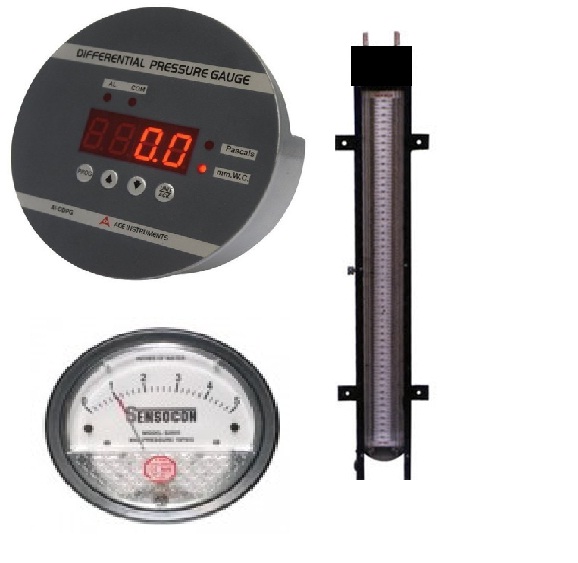Analytical Instrument
Leading Manufacturers, Exporters, Wholesaler of Chart Recorder, Online Analyzer, Analytical Instruments, Diesel Test Benches, Digital pH Meter and Digital Manometer from Ahmedabad.
| Business Type | Manufacturer, Exporter, Supplier |
| Color | Silver |
| Condition | New |
| Automatic Grade | Automatic |
| Power Source | Electric |
| Application | Temperature Pressure Flow Level |
| Certification | CE Certified |
| Feature | Compact Size, Long Working Life, Sturdy Design |
| Voltage | 220V |
| Type | Chart Recorder |
| Country of Origin | India |
| Payment Terms | T/T |
| Packaging Details | Box |
A chart recorder is a mechanical or electronic device that visually tracks and records changes in a variable over time. Traditionally, they used a rotating chart with a pen that marked the value of the variable on the paper as time passed. Modern versions often use digital displays and electronic storage.
Here's a quick rundown of chart recorders with some key specifications to consider:
Function:
· Monitors and records variations in a measured quantity (e.g., temperature, pressure, flow rate) over time.
· Creates a permanent record that can be analyzed later.
Types:
· Mechanical: Uses a pen to draw on a rotating paper chart.
· Electronic: Employs digital displays and electronic data storage.
Specifications (to consider when choosing a chart recorder):
· Input type: The type of signal the recorder can accept (e.g., voltage, current, thermocouple).
· Number of channels: How many variables can be recorded simultaneously.
· Chart speed: How fast the paper chart rotates (mechanical) or how often data is captured (electronic).
· Accuracy: The level of precision in the recorded measurements.
· Chart size: The diameter or width of the paper chart (mechanical).
· Data storage: How data is stored in electronic recorders (e.g., internal memory, SD card).
Applications:
· Industrial processes: Monitoring and recording variables in factories, power plants, and other industrial settings.
· Scientific research: Tracking and analyzing changes in experiments or environmental conditions.
· Weather monitoring: Recording temperature, pressure, and humidity over time.
· Medical applications: Monitoring vital signs like heart rate and blood pressure.
Overall, chart recorders provide a valuable tool for visualizing and recording trends in various applications. By considering the specifications mentioned above, you can choose the right chart recorder for your specific needs.
Additional functionalities:
· Alarm systems: Some chart recorders can be set with alarms to trigger if a measured value exceeds a certain threshold.
· Event markers: Users can manually mark specific events on the chart to correlate them with recorded data (e.g., equipment maintenance performed).
· Communication interfaces: Modern chart recorders may offer interfaces like USB or Ethernet for data transfer to computers for further analysis or storage.
Selection factors beyond specifications:
· Environmental conditions: Consider the operating temperature, humidity, and presence of dust or vibrations where the recorder will be used.
· Power supply: Choose a recorder with a compatible power source (AC/DC) and consider backup options if needed.
· Portability: If the recorder needs to be moved frequently, size and weight might be important factors.
· Cost: Chart recorders can range in price depending on their features and complexity.
Modern vs. Traditional Chart Recorders:
· Traditional (mechanical):
o Offer a simple and reliable way to visualize trends.
o May be limited in data storage and retrieval capabilities.
o Require replacing paper charts regularly.
· Modern (electronic):
o Provide greater flexibility in data storage, analysis, and export.
o Can offer higher accuracy and more channels for recording multiple variables.
o May have a higher initial cost compared to traditional models.
Specialized Applications (specific examples):
· Manufacturing: Recording temperature profiles during heat treatment processes or monitoring pressure fluctuations in hydraulic systems.
· Power Plants: Tracking generator output over time or monitoring critical parameters like boiler temperature and pressure.
· Water Treatment Facilities: Recording chlorine levels or monitoring water flow rates.
· Environmental Monitoring: Tracking air quality data or recording water levels in rivers or lakes.
· Scientific Research and Development: Chart recorders are used to track various parameters in experiments, such as temperature changes during chemical reactions, pressure variations in wind tunnels, or strain gauges measuring forces on materials.
· Medical Applications: In some cases, chart recorders are used to monitor vital signs like heart rate, blood pressure, and respiration during surgeries or intensive care situations.
· Building Automation and HVAC Systems: They can be employed to record temperature, humidity, and energy consumption data in buildings, helping to optimize energy usage and maintain comfortable conditions.
· Data Acquisition Systems (DAQ): Chart recorders can be integrated into DAQ systems for comprehensive data collection and analysis in various scientific, industrial, and environmental monitoring applications.
Advanced Features:
· Data Logging and Analysis: Modern recorders can store data electronically, allowing for later retrieval, analysis, and visualization on computers. Software might be included for data manipulation and generation of reports.
· Multi-channel Recording: Some recorders can handle multiple input signals simultaneously, enabling the tracking of several variables on a single chart or in separate data files. This is useful for analyzing correlations between different parameters.
· Alarm Systems and Event Markers: As mentioned before, these features can be crucial for process monitoring and troubleshooting. Alarms can notify operators of critical situations, while event markers help correlate recorded data with specific events.
· Communication Interfaces: Connectivity options like USB, Ethernet, or Wi-Fi allow for data transfer to computers or cloud storage for remote monitoring and analysis. This is beneficial for centralized data management and real-time access.
· Programmable Functions: Advanced recorders may allow users to program specific chart speeds, data logging intervals, and alarm triggers based on their application needs.
Additional Considerations:
· Regulatory Compliance: In some industries, specific regulations might dictate the type of data recording required. Chart recorders can provide verifiable documentation for audits or safety compliance purposes.
· User Interface and Usability: The ease of use and clarity of the user interface, especially for data retrieval and analysis in electronic recorders, are important factors to consider.
The Future of Chart Recorders: Trends and Innovations
While traditional mechanical chart recorders are still valuable in specific applications, the future of chart recording is undoubtedly with electronic models. Here's a glimpse into some exciting trends and innovations:
Advancements in Digital Technology:
· Enhanced Data Processing and Analysis: Expect more sophisticated software capabilities for data manipulation, filtering, and trend analysis. This will allow users to extract even deeper insights from recorded data.
· Improved Communication and Connectivity: Advanced wireless communication protocols and integration with cloud platforms will enable real-time data access and remote monitoring capabilities.
· Touchscreen Interfaces and User Experience: Intuitive touchscreen interfaces and user-friendly software will make chart recorders even easier to operate and navigate.
Emerging Applications:
· Internet of Things (IoT) Integration: Chart recorders could become part of a larger IoT network, sending data to cloud platforms for real-time monitoring and control of various industrial processes or environmental conditions.
· Big Data and Machine Learning: Integration with big data analytics and machine learning algorithms could allow for predictive maintenance and anomaly detection based on historical data trends.
· Portable and Wearable Devices: Miniaturization and advancements in battery technology could lead to the development of portable and even wearable chart recorders for specialized applications.
Focus on Sustainability:
· Energy Efficiency: Manufacturers are likely to focus on developing energy-efficient chart recorders with features like auto-shutoff and low-power operation.
· Environmentally Friendly Materials: The use of recyclable materials and eco-friendly manufacturing processes will become increasingly important.
Challenges and Considerations:
· Cybersecurity: As chart recorders become more interconnected, robust cybersecurity measures will be essential to protect sensitive data from unauthorized access or manipulation.
· Data Privacy: Regulations and best practices for data privacy will need to be addressed as chart recorders collect and store increasingly detailed information.
· User Training and Expertise: With advanced features, user training and expertise in data analysis might become more critical in some applications.
The future of chart recorders is likely to involve a blend of these trends, making them even more versatile and valuable tools for various data acquisition and monitoring needs. They will offer improved functionality, remote access capabilities, and integration with emerging technologies like IoT and big data analytics. However, addressing cyber security concerns and ensuring responsible data management will be crucial considerations.
| Business Type | Manufacturer, Exporter, Supplier |
| Color | Plastic |
| Application | Industrial Use |
| Feature | Accuracy,Digital Display,Highly Competitive |
| Type | On Line ANALYZER |
| Country of Origin | India,India |
| Material | Metal |
| Packaging Type | Box |
| Used In | Power Sector, Pharmaceutical industry, Government Organization, Food industry, Sugar industry |
We offer On-line Analyzer that is designed to give high performance and caters to the requirement of diverse process control instrument applications. We offer superior variety of On-line Analyzer that is highly praised for superior analytical accuracy and durability among clients all over the world. Today, we are listed as one of the prime On-line Analyzer Manufacturers and Exporters.
Highlighting Features
- High accuracy
- Effectual functioning
- Dependable
- Low maintenance cost
- Compact design
Used In
- Power Sector
- Pharmaceutical industry
- Government Organization
- Food industry
- Sugar industry
- Textile industry
- Dyes Intermediates
- Drug industry
- Fertilizer industry
- Soil industry
| Business Type | Manufacturer, Exporter, Supplier |
| Driven Type | Electric |
| Color | Blue |
| Condition | New |
| Automation Grade | Automatic |
| Style | Analytical |
| Certification | CE Certified |
| Type | Analytical Instruments |
| Country of Origin | India |
| System | 4-20 for Scada DCS |
| Payment Terms | T/T |
| Packaging Details | Analytical Instruments |
In the scientific and industrial world, understanding the composition and properties of materials is fundamental. Analytical instruments act as our eyes and ears into the unseen world, providing crucial insights into the chemical makeup, physical characteristics, and structure of various substances. Here's a breakdown of what analytical instruments are and the key roles they play:
Function:
· Analytical instruments encompass a diverse range of tools used to analyze the chemical and physical properties of materials.
· They can be used for qualitative analysis (identifying the components of a sample) or quantitative analysis (determining the amount of each component present).
· These instruments play a vital role in various fields like:
o Chemistry
o Biology
o Physics
o Environmental Science
o Materials Science
o Forensics
o Pharmaceutical Manufacturing
o Food and Beverage Production
Types of Analytical Instruments:
The vast array of analytical instruments can be categorized based on the analytical technique they employ:
· Spectroscopic Techniques: These instruments analyze the interaction of light or radiation with a sample. Common examples include:
o Mass Spectrometry (MS): Identifies and quantifies molecules based on their mass-to-charge ratio.
o Atomic Absorption Spectroscopy (AAS): Measures the concentration of specific elements by analyzing the light absorbed by the sample.
o Ultraviolet-Visible (UV-Vis) Spectroscopy: Analyzes the absorption of ultraviolet and visible light by a sample to determine its composition.
· Chromatographic Techniques: These techniques separate the components of a mixture based on their interaction with a stationary phase. Common examples include:
o High-Performance Liquid Chromatography
(HPLC): Separates and analyzes complex mixtures of liquids.
o Gas Chromatography (GC): Separates and analyzes volatile compounds.
· Electrochemical Techniques: These techniques involve measuring the electrical properties of a sample. Examples include:
o pH Meters: Measure the acidity or alkalinity of a solution.
o Conductivity Meters: Measure the ability of a solution to conduct electricity.
· Microscopic Techniques: These instruments provide magnified images of a sample for detailed analysis. Examples include:
o Optical Microscopes: Provide high-resolution images of a sample's surface features.
o Electron Microscopes: Offer much higher magnification than optical microscopes, allowing visualization of structures at the atomic level.
Benefits of Using Analytical Instruments:
· Improved Quality Control: Allow manufacturers to ensure their products meet specific quality standards.
· Environmental Monitoring: Help monitor air, water, and soil quality for contaminants.
· Medical Diagnosis: Assist doctors in diagnosing diseases by analyzing blood, tissue, and other biological samples.
· Material Characterization: Enable scientists and engineers to understand the properties of new materials.
· Forensic Investigations: Provide valuable evidence for criminal investigations.
· Advancement of Scientific Research: Play a critical role in scientific discoveries and innovations.
Choosing the Right Instrument:
Selecting the appropriate analytical instrument depends on various factors:
· The type of sample being analyzed: Solid, liquid, or gas?
· The specific information desired: Composition, structure, or physical properties?
· The desired level of accuracy and sensitivity.
· Cost and budgetary limitations.
The Future of Analytical Instruments:
The field of analytical instrumentation is constantly evolving. Here are some trends to watch for:
· Miniaturization: Development of smaller, portable instruments for on-site analysis.
· Increased Automation: Instruments with greater automation capabilities for faster and more efficient analysis.
· Improved Sensitivity: Ability to detect even smaller quantities of analytes.
· Integration with Artificial Intelligence: Utilizing AI for data analysis and interpretation.
Conclusion:
Analytical instruments are the unsung heroes of science and industry, providing us with the power to unlock the secrets hidden within materials. By understanding their diverse functionalities and the ever-evolving landscape, we can leverage these tools to advance research, ensure quality, and solve problems across various fields.
| Business Type | Manufacturer, Exporter, Supplier |
| Driven Type | Electric |
| Condition | New |
| Automatic Grade | Automatic |
| Application | Testing Fuel Injectors |
| Certification | CE Certified, ISO 9001:2008 |
| Voltage | 220V |
| Type | Fuel Injection Test Bench |
| Country of Origin | India |
Test benches are the workhorses of the engineering world, providing a controlled environment to evaluate the performance, functionality, durability, and safety of various equipment and systems. Imagine them as the training grounds where machines get pushed to their limits, ensuring they are ready for real-world applications. Here's a deep dive into the different types of test benches and their key specifications:
Types of Test Benches:
The specific type of test bench depends on the equipment or system under test (EUT). Here are some common varieties:
· Engine Test Benches: Simulate real-world driving conditions to evaluate engine performance metrics like power output, fuel efficiency, and emissions. These benches can handle a wide range of engines, from small gasoline engines to massive diesel engines used in ships.
· Motor Test Benches: Assess the performance of electric motors, measuring factors like torque, speed, and efficiency. They are crucial for developing and optimizing electric motors used in electric vehicles, industrial applications, and household appliances.
· Hydraulic Test Benches: Evaluate the performance and durability of hydraulic components like pumps, valves, and actuators. These benches can simulate various pressure and flow conditions to ensure hydraulic systems function reliably under stress.
· Environmental Test Benches: Expose EUTs to extreme temperatures, humidity, vibration, and other environmental conditions. They are used to ensure equipment can withstand harsh environments and function reliably in various climates.
· Power Electronics Test Benches: Test the functionality and performance of power electronics equipment like inverters, converters, and battery management systems. These benches provide a controlled environment to assess power conversion efficiency, safety features, and overall system stability.
· Functional Test Benches: Focus on verifying the functionality of electronic devices and systems. They simulate real-world usage scenarios and test various features and functionalities to ensure proper operation.
Crucial Specifications to Consider:
When choosing a test bench, several key specifications need to be considered to ensure it meets your testing needs:
· Load Capacity: The maximum force, torque, pressure, or flow rate the test bench can apply to the EUT. This should be sufficient to simulate the most demanding operating conditions the EUT will encounter.
· Power Supply Capabilities: The type and capacity of the power supply needed to operate the EUT. This can include AC or DC power, with varying voltage and current ratings.
· Data Acquisition and Control Systems: The capabilities of the system to collect and analyze data from the EUT during testing. This includes sensors, data loggers, and control software for setting test parameters and analyzing results.
· Environmental Controls: The ability of the test bench to control environmental factors like temperature, humidity, and vibration. This is crucial for environmental testing and ensuring the EUT performs reliably in various conditions.
· Safety Features: The safety measures incorporated into the test bench to protect personnel and equipment during testing. This includes emergency shut-off systems, proper ventilation for emissions, and proper grounding for electrical safety.
· Software and Automation: The level of automation offered by the test bench's software for controlling the test process, analyzing data, and generating reports. Advanced automation allows for more efficient and reproducible testing.
· Footprint and Ergonomics: The physical size and layout of the test bench, including considerations for accessibility, maintenance, and operator safety.
Beyond the Basics: Additional Considerations
· Scalability: Consider the potential need to test larger or more powerful equipment in the future.
· Compliance with Standards: Ensure the test bench meets relevant industry standards and regulations for testing specific equipment types.
· Cost and Maintenance: Evaluate the initial investment and ongoing maintenance requirements of the test bench.
In Conclusion:
Test benches are invaluable tools for ensuring the quality, reliability, and safety of various equipment and systems. By understanding the different types of test benches and their key specifications, you can choose the most appropriate one to meet your specific testing needs. These versatile workhorses will continue to play a vital role in developing and optimizing technologies across various industries
| Business Type | Manufacturer, Exporter, Supplier |
| Body Material | Mild Steel |
| Color | Silver |
| Automatic Grade | Automatic |
| Power Source | Electric |
| Application | Indsustrial Usage |
| Certification | CE Certified |
| Feature | Accuracy, Durable, Light Weight, Low Power Comsumption, Stable Performance |
| Display Type | Digital |
| Type | Digital Ph Meters |
| Country of Origin | India |
| Product Code | Anya |
| Port | Any |
| Payment Terms | T/T |
| Delivery Time | Any |
| Packaging Details | Any |
A digital pH meter is an electronic instrument used to measure the acidity or alkalinity of a liquid. It measures the concentration of hydrogen ions (H+) in the liquid, which determines its pH level. A lower pH indicates a more acidic solution, while a higher pH indicates a more basic or alkaline solution. Here's a detailed explanation of digital pH meters with their specifications:
Components of a Digital pH Meter:
· Electrode: The most crucial component, it consists of a glass bulb that is sensitive to hydrogen ions. The bulb is filled with a reference solution and has a silver chloride (AgCl) reference electrode in contact with the solution. When the electrode is submerged in a liquid, an electrical potential is generated between the reference electrode and the hydrogen ions in the liquid.
Digital PH Meter Electrode
· Reference Electrode: Maintains a stable electrical potential within the meter.
· Converter: Converts the electrical signal from the electrode into a pH reading.
· Display: Shows the measured pH value in a digital format.
· Temperature Probe (Optional): Some meters have a built-in temperature probe to account for temperature variations that can affect pH readings.
· Calibration Solutions: Buffers with known pH values used to calibrate the meter for accurate readings.
Specifications to Consider When Choosing a Digital pH Meter:
· pH Range: The range of pH values the meter can measure (typically from 0 to 14 pH).
· Accuracy: The level of precision in the pH readings (usually specified in ±pH units).
· Resolution: The smallest difference in pH that the meter can detect (often 0.01 pH or 0.1 pH).
· Calibration: The number of calibration points the meter allows (typically 1 to 3 points). More calibration points generally improve accuracy.
· Temperature Compensation: Automatic or manual adjustment for temperature variations affecting readings.
· Data Logging and Memory (Optional): Some meters can store readings for later analysis or transfer to a computer.
· Electrode Type: Consider refillable, gel-filled, or solid-state electrodes depending on your needs and budget. Refillable electrodes offer higher accuracy but require more maintenance.
· Durability and Portability: Think about the meter's housing material, weight, and portability for your application.
Applications of Digital pH Meters:
· Hydroponics and Gardening: Monitoring nutrient solution pH for optimal plant growth.
· Swimming Pools and Spas: Maintaining proper pH levels for disinfection and swimmer comfort.
· Aquariums: Ensuring suitable pH levels for fish and aquatic life.
· Food and Beverage Industry: Monitoring pH during food processing and production to ensure quality and safety.
· Chemical Industry: Measuring pH levels in various chemical solutions for control and analysis.
· Environmental Monitoring: Testing the pH of water bodies to assess water quality.
· Scientific Research: Measuring pH in various experiments and investigations.
Using a Digital pH Meter:
1. Calibrate the meter with standard buffer solutions according to the manufacturer's instructions.
2. Turn on the meter and allow it to warm up if necessary.
3. Rinse the electrode with distilled water and blot it dry with a lint-free paper.
4. Immerse the electrode in the liquid to be measured.
5. Stir the liquid gently to ensure good contact with the electrode.
6. Wait for the reading to stabilize on the display.
7. Record the pH reading and rinse the electrode again for storage.
Here are some additional tips for using a digital pH meter:
· Always follow the manufacturer's instructions for your specific meter model.
· Use fresh calibration buffers regularly.
· Store the electrode properly in the recommended storage solution when not in use.
· Clean the electrode regularly according to the manufacturer's recommendations.
By understanding the specifications and proper use of digital pH meters, you can ensure accurate and reliable pH measurements in various applications.
| Business Type | Manufacturer, Exporter, Supplier |
| Material | Mild Steel |
| Color | Black |
| Condition | New |
| Automatic Grade | Automatic |
| Application | Industrial Use |
| Feature | Accuracy, Easy To Fit, Measure Fast Reading, Perfect Strength |
| Display Type | Digital |
| Type | Digital Manometers |
| Country of Origin | India |
| Payment Terms | T/T |
| Packaging Details | Box |
In a nutshell, a digital manometer is a pressure measuring device that ditches the old-school liquids (like mercury) for a modern, electronic approach.
Here's the gist:
· Digital Readout: Shows pressure on a screen in easy-to-read numbers (psi, kPa, etc.), unlike traditional manometers that rely on liquid levels.
· More Accurate: Offers higher accuracy, especially across broader pressure ranges.
· Easy to Use: No need to decipher liquid levels, making it simpler to read and record measurements.
· Portable and Compact: Often smaller and lighter than traditional models, enhancing portability.
· Extra Features (on some models): May offer data logging for recording measurements over time, or show minimum and maximum pressure readings.
Used in:
· HVAC Systems: Monitoring air pressure in ventilation ducts.
· Pneumatic Systems: Checking for pressure problems in compressed air lines.
· Fluid Flow: Measuring pressure drops in pipes.
· Even Medicine: Special models can monitor blood pressure.


